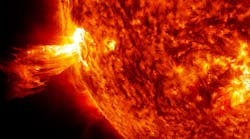NASA’s latest mission, called the Sun Radio Interferometer Space Experiment (SunRISE), consists of six CubeSats operating as a single large radio telescope. NASA has awarded $62.6 million to design, build and launch SunRISE by no earlier than July 1, 2023.
NASA designed it to learn more about how the sun generates and throws off giant space weather storms, known as solar particle storms. SunRISE will gather information on how the solar system works. Knowing this could help NASA protect astronauts traveling to the Moon and Mars.
NASA chose SunRISE in August 2017. The 11-month mission relies on six solar-powered CubeSats, each about the size of a toaster oven, to simultaneously observe radio images of low-frequency emission from solar activity and share them via NASA’s Deep Space Network. The array of CubeSats would fly within six miles of each other, above Earth’s atmosphere, which otherwise blocks radio signals SunRISE want to detect.
The CubeSats will create 3D maps that pinpoint where giant particle bursts originate on the sun and how they evolve as they expand into space. This, in turn, will help determine what initiates and accelerates these giant radiation jets of radiation. The spacecraft will also work together to map the magnetic field lines reaching from the sun out into interplanetary space.
This is one of NASA’s Missions of Opportunity, designed to maximize the scientific knowledge gained by piggybacking new, relatively inexpensive missions on rocket launches already approved and preparing to go into space. SunRISE, for example, is scheduled to rideshare on a rocket carrying a commercial satellite provided by Maxar of Westminster, Colo. Once in orbit, the host spacecraft will deploy the six SunRISE CubeSats and then continue its prime mission.

